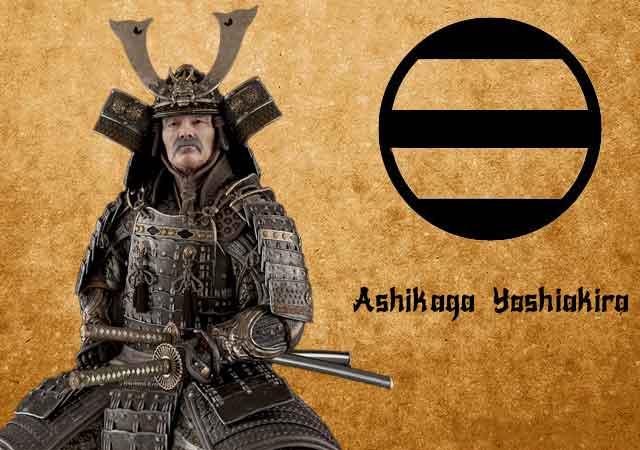
Ashikaga Yoshiakira (July 4, 1330 – December 28, 1367) served as the second shogun of the Ashikaga shogunate from 1358 to 1367 during Japan's Muromachi period. He was the son of Ashikaga Takauji, the founder and inaugural shogun of the Muromachi shogunate. His mother, known as Akahashi Toshi or Hojo Nariko, was Takauji's consort.
During his early years, Yoshiakira, then known as Senjuo, resided in Kamakura as a hostage under the guardianship of the Hojo clan. His father, Takauji, aligned himself with the exiled Emperor Go-Daigo, who led a rebellion against the Kamakura shogunate in what is known as the Kenmu Restoration. Yoshiakira actively supported Nitta Yoshisada (1301–1338) in the attack against the Kamakura shogunate. Throughout the Nanboku-cho period, Yoshiakira successfully reclaimed Kyoto from various Loyalist occupations in the 1350s.
In 1349, internal turmoil within the government necessitated Yoshiakira's return to Kyoto, where he was designated as Takauji's heir. On April 5, 1352, Loyalist forces led by Kitabatake Akiyoshi, Kusunoki Masanori, and Chigusa Akitsune seized Kyoto for a period of 20 days before Yoshiakira managed to recapture the city. In July 1353, Loyalist forces under the command of Masanori and Yamana Tokiuji once again took control of Kyoto, only to be repelled by Yoshiakira in August. In January 1355, Loyalist forces led by Momonoi, Tadafuyu, and Yamana once more captured Kyoto. However, on April 25, Takauji and Yoshiakira's combined forces successfully reclaimed the city. Following his father Takauji's passing in 1358, Yoshiakira assumed the title of Sei-i Taishogun.
Upon Takauji's death in 1358, Yoshiakira's appointment as shogun led to discord and defections within the shogunate. In 1362, Hosokawa Kiyouji and Kusunoki Masanori launched an attack on Kyoto. Yoshiakira fled the city but managed to retake it within twenty days. Later, in 1365, Prince Kaneyoshi (also known as Kanenaga), the son of Emperor Go-Daigo and leader of the rival Ashikaga court, gained control of Kyushu. In 1367, Yoshiakira fell seriously ill and passed on his position to his son.
Several months after his demise, he was succeeded by his son Ashikaga Yoshimitsu, who assumed the role of the third shogun in 1368. Yoshiakira was posthumously honored with the title Hokyoin, and his resting place is located at Toji-in in Kyoto, the same site as his father's grave.
See also
-
Yamagata Masakage

Masakage was one of Takeda Shingen’s most loyal and capable commanders. He was included in the famous list of the “Twenty-Four Generals of Takeda Shingen” and also belonged to the inner circle of four especially trusted warlords known as the Shitennō.
-
Yagyu Munenori

Yagyū Munenori began his service under Tokugawa Ieyasu while his father, Yagyū Muneyoshi, was still at his side. In 1600, Munenori took part in the decisive Battle of Sekigahara. As early as 1601, he was appointed a kenjutsu instructor to Tokugawa Hidetada, Ieyasu’s son, who later became the second shogun of the Tokugawa clan.
-
Yagyu Muneyoshi

A samurai from Yamato Province, he was born into a family that had been defeated in its struggle against the Tsutsui clan. Muneyoshi first took part in battle at the age of sixteen. Due to circumstances beyond his control, he was forced to enter the service of the Tsutsui house and later served Miyoshi Tōkei. He subsequently came under the command of Matsunaga Hisahide and in time became a vassal first of Oda and later of Toyotomi.
-
Endo Naozune

Naozune served under Azai Nagamasa and was one of the clan’s leading vassals, renowned for his bravery and determination. He accompanied Nagamasa during his first meeting with Oda Nobunaga and at that time asked for permission to kill Nobunaga, fearing him as an extremely dangerous man; however, Nagamasa did not grant this request.
-
Hosokawa Sumimoto

Sumimoto came from the Hosokawa clan: he was the biological son of Hosokawa Yoshiharu and at the same time the adopted son of Hosokawa Masamoto, the heir of Hosokawa Katsumoto, one of the principal instigators of the Ōnin War. Masamoto was homosexual, never married, and had no children of his own. At first he adopted Sumiyuki, a scion of the aristocratic Kujō family, but this choice provoked dissatisfaction and sharp criticism from the senior vassals of the Hosokawa house. As a result, Masamoto changed his decision and proclaimed Sumimoto as his heir, a representative of a collateral branch of the Hosokawa clan that had long been based in Awa Province on the island of Shikoku. Almost immediately after this, the boy became entangled in a complex and bitter web of political intrigue.
-
Honda Masanobu

Masanobu initially belonged to the retinue of Tokugawa Ieyasu, but later entered the service of Sakai Shōgen, a daimyo and priest from Ueno. This shift automatically made him an enemy of Ieyasu, who was engaged in conflict with the Ikkō-ikki movement in Mikawa Province. After the Ikkō-ikki were defeated in 1564, Masanobu was forced to flee, but in time he returned and once again entered Ieyasu’s service. He did not gain fame as a military commander due to a wound sustained in his youth; nevertheless, over the following fifty years he consistently remained loyal to Ieyasu.
-
Honda Masazumi

Masazumi was the eldest son of Honda Masanobu. From a young age, he served Tokugawa Ieyasu alongside his father, taking part in the affairs of the Tokugawa house and gradually gaining experience in both military and administrative matters. At the decisive Battle of Sekigahara in 1600, Masazumi was part of the core Tokugawa forces, a clear sign of the high level of trust Ieyasu placed in him. After the campaign ended, he was given a highly sensitive assignment—serving in the guard of the defeated Ishida Mitsunari, one of Tokugawa’s principal enemies—an obligation that required exceptional reliability and caution.
-
Hojo Shigetoki

Hōjō Shigetoki, the third son of Hōjō Yoshitoki, was still very young—only five years old—when his grandfather Tokimasa became the first member of the Hōjō clan to assume the position of shogunal regent.

